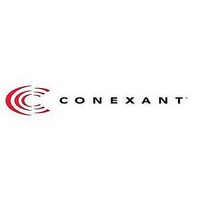cx82100 Conexant Systems, Inc., cx82100 Datasheet - Page 107

cx82100
Manufacturer Part Number
cx82100
Description
Home Network Processor Hnp
Manufacturer
Conexant Systems, Inc.
Datasheet
1.CX82100.pdf
(226 pages)
Available stocks
Company
Part Number
Manufacturer
Quantity
Price
Part Number:
cx82100-11
Manufacturer:
CONEXANT
Quantity:
20 000
Company:
Part Number:
cx82100-41
Manufacturer:
CONEXANT
Quantity:
179
Company:
Part Number:
cx82100-41
Manufacturer:
CONEXANT
Quantity:
16
Part Number:
cx82100-41
Manufacturer:
CONEXANT
Quantity:
20 000
Company:
Part Number:
cx82100-41Z
Manufacturer:
CONEXANT
Quantity:
28
Part Number:
cx82100-41Z
Manufacturer:
CONEXANT
Quantity:
20 000
Company:
Part Number:
cx82100-51
Manufacturer:
CONEXANT
Quantity:
12
7.7
7.7.1
101306C
TMAC Architecture
Transmit Frame Structure
Conexant Proprietary and Confidential Information
Before the host requests transmission of a frame, it constructs the data (LLC data) field of
the frame in memory. The TMAC appends a preamble and a SFD to the beginning of the
frame. Using information from the descriptor, TMAC also appends a PAD at the end of
the data field of sufficient length to ensure that the transmitted frame length satisfies a
minimum frame. TMAC then attempts to avoid contention with other traffic on the
medium by monitoring the carrier sense signal provided by the Ethernet PHY and
deferring to passing traffic. When the medium is clear, frame transmission is initiated
(after a brief interframe delay to provide recovery time for other devices on the medium).
The TMAC then provides data nibbles to the EPHY on the MII.
The EPHY monitors the medium and generates the collision detect signal, which, in the
contention-free case, remains off for the duration of the frame. When transmission has
completed without contention, the TMAC informs the host by writing status into the
memory and awaits the next request.
Before the TMAC can start transmitting a frame containing the LLC data, a transmit
message structure as shown in Figure 7-5 must be constructed by the host in ARM's
memory. TMAC reads data from the memory (via DMA channel 1 or 3) to transmit via
MII and writes data into the memory to update the status. The ARM host is the master for
TMAC transmit operations and serves data to the TMAC via the APB. It is also the host's
task to assemble Ethernet frames to be sent out by the TMAC. The transmit descriptor
(TDES), the transmit status (TSTAT), and the sequence of transmitter DMA operation
are described below. Note that the qword count which is to be loaded into the
DMAC_{x}_CNT1 register should always include the first qword reserved for the
transmit status.
CX82100 Home Network Processor Data Sheet
7-9












